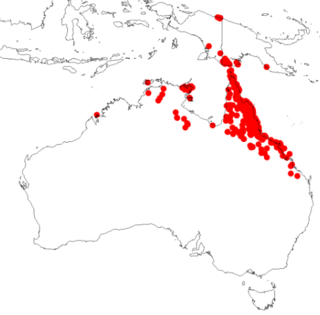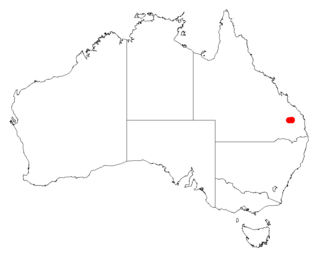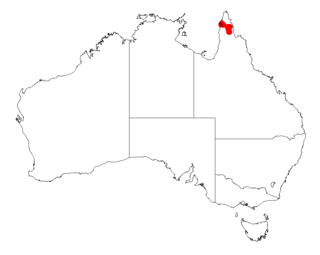
Acacia thomsonii, commonly known as Thomson's wattle, is a shrub or tree belonging to the genus Acacia and the subgenus Juliflorae that native to parts of northern Australia.

Acacia crassiuscula is a shrub belonging to the genus Acacia and the subgenus Phyllodineae found along the south coast of Western Australia.

Acacia pharangites, commonly known as Wongan gully wattle, is a shrub of the genus Acacia and the subgenus Plurinerves that is endemic to the Wongan Hills of south western Australia and is listed as endangered according to the Environment Protection and Biodiversity Conservation Act 1999.

Acacia veronica, commonly known as Veronica's wattle, is a shrub or tree of the genus Acacia and the subgenus Plurinerves that is endemic to a small area of south western Australia.

Acacia abbatiana is a species of flowering plant in the family Fabaceae and is endemic to Mount Abbott in Queensland. It has linear phyllodes, flowers arranged in a spike about 5 mm (0.20 in) in diameter, and a pod up to 35 mm (1.4 in) long.

Acacia simsii is a shrub belonging to the genus Acacia in the family Fabaceae. It is native to New Guinea and northern Australia. In Australia it is found in both the Northern Territory and Queensland.

Acacia eremophiloides is a shrub belonging to the genus Acacia and the subgenus Phyllodineae that is endemic to Queensland.

Acacia falciformis, also commonly known as broad-leaved hickory, hickory wattle, mountain hickory, large-leaf wattle, tanning wattle and black wattle, is a shrub belonging to the genus Acacia and the subgenus Phyllodineae that is endemic to eastern Australia

Acacia holotricha is a shrub belonging to the genus Acacia and the subgenus Phyllodineae that is native to parts of north eastern Australia.

Acacia caroleae, also known as Carol's wattle or narrow leaf currawong, is a shrub belonging to the genus Acacia and the subgenus Juliflorae that is native to north eastern Australia.

Acacia hyaloneura is a shrub or tree belonging to the genus Acacia and the subgenus Juliflorae that is native to north eastern Australia.

Acacia ammophila is a tree or shrub belonging to the genus Acacia. It is native to Queensland.

Acacia tenuinervis is a shrub or tree belonging to the genus Acacia and the subgenus Juliflorae that is native to north eastern Australia.
Acacia polyadenia is a shrub or small tree belonging to the genus Acacia and the subgenus Juliflorae that is native to north eastern Australia.

Acacia legnota, also known as heath wattle, is a shrub of the genus Acacia and the subgenus Plurinerves that is endemic to an area of north eastern Australia.

Acacia leptoloba, also known as Irvinebank wattle, is a shrub of the genus Acacia and the subgenus Plurinerves that is endemic to an area of north eastern Australia.

Acacia melvillei, commonly known as yarran, is a shrub of the genus Acacia and the subgenus Plurinerves that is endemic to south eastern Australia.

Acacia ommatosperma is a shrub of the genus Acacia and the subgenus Plurinerves that is endemic to an area of north western Australia.

Acacia tephrina, commonly known as boree, is a tree of the genus Acacia and the subgenus Plurinerves that is endemic to an area of north eastern Australia. It is rated as being of least concern according to Nature Conservation Act 1992.

Daviesia flava is a species of flowering plant in the family Fabaceae and is endemic to Queensland. It is a glabrous shrub with linear or narrowly egg-shaped phyllodes, and uniformly yellow flowers.




















